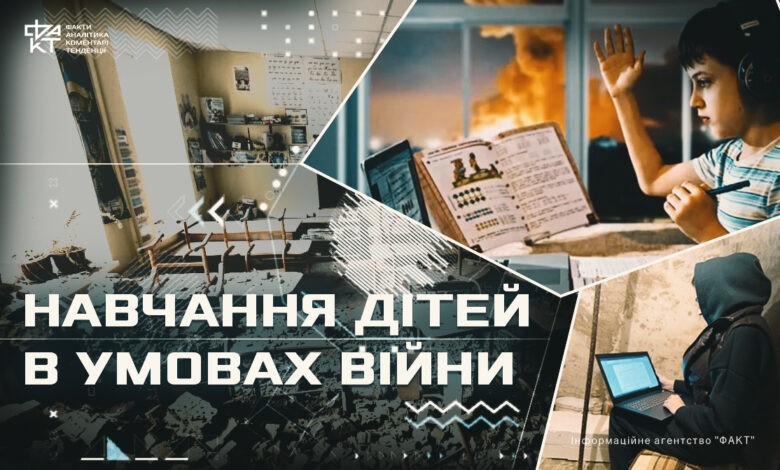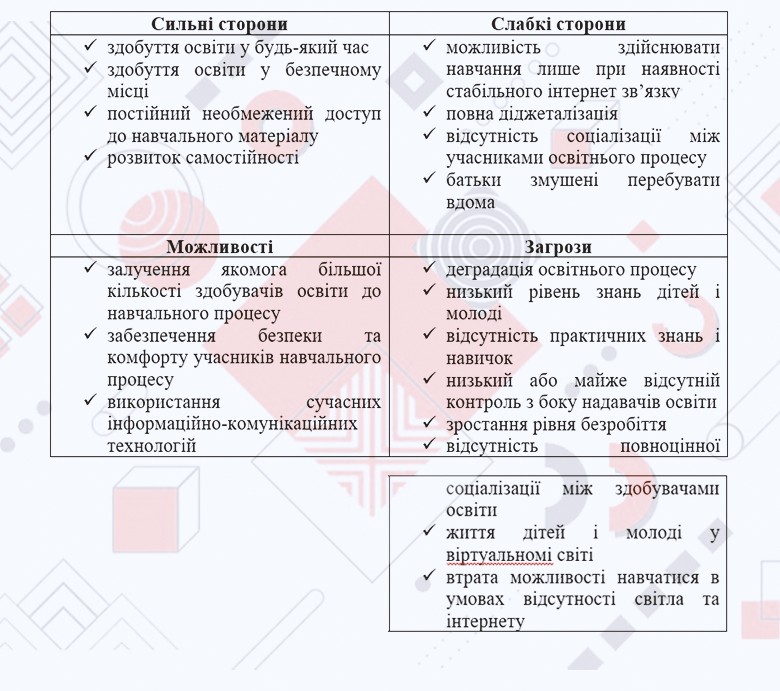Distance education in wartime conditions: SWOT analysis

Distance education in Ukraine has been one of the important forms of the modern educational process for several years. According to the “Concept for the Development of Distance Education in Ukraine” adopted in December 2000, it is defined as “a system of technologies that guarantees prompt delivery of a sufficient scale of the studied material to those seeking education; interactive interaction of teachers and students in the educational process, providing individuals with a reserve of independent work on mastering the proposed material.”
The experience gained during the quarantine caused by the COVID-19 virus played an important role in restoring the educational process in the conditions of a full-scale invasion. Currently, education seekers and their parents have a difficult choice of which form to study: face-to-face or distance learning, to get a job at another educational institution as an IDP, a refugee, or to stay to study in their city.
The State Service for the Quality of Education of Ukraine presented the results of the study of the quality of the organization of the educational process in the conditions of war in the 2023/2024 academic year. In the second year of the full-scale war, the vast majority of educational institutions managed to resume face-to-face education in the first half of the 2023/2024 academic year: 53% of institutions worked face-to-face, 19% – remotely, and 28% – mixed. The distance form of education mostly prevailed in the territories of the East and partially in the South. While in the Center and the West of Ukraine, face-to-face education prevailed, and in the North – mixed education. The correct organization of distance learning and the search for a balance in the use of resources provide both learners and providers of education with the opportunity to effectively carry out the educational process. It is the distance form of education that gives students of education constant and unlimited access to educational material with the presence of the Internet, and the use of modern technologies considerably speeds up and facilitates the acquisition of knowledge.
However, this format has significant drawbacks that can significantly worsen the quality of education. Unstable conditions for the organization of the educational process (air raids, artillery shelling, disconnection of the Internet and mobile communications) often make the distance learning process impossible.
How was the 2023-2024 academic year
According to a survey of teachers in the 2023-2024 academic year, about 20% of education seekers did not have permanent access to the educational process. Among these, the greatest value was achieved in the South (30%).
There is also a difference between urban and rural areas and access to it by families with different levels of wealth:
– in cities, 75% of teachers believe that all students from low-income families have access to education, from families with many children – 80%, from among IDPs – 86%;
– in villages, 62% of teachers believe that all students from low-income families have access to education, from families with many children – 69%, from among IDPs – 73%.
In the school year that recently ended, about 20% of students did not have constant access to the educational process in the conditions of war. At the same time, 97% of schools had no losses in the educational process, that is, they constantly carried out the educational process. However, despite the fact that educational institutions were almost constantly working, only 42% of schoolchildren’s parents indicated that their children were constantly studying. The main reasons are illness, inability to connect to online lessons, overload, lack of motivation, unstable emotional state. It should be noted that this academic year parents of students were informed that their children did not study also due to power outages, lack of internet and/or weak connection, as well as air alarms.
Despite the global digitization, 32% of the interviewed education seekers indicated that the shelter where they were during the air raids did not have the conditions for conducting lessons. In the East and North of Ukraine, this indicator is the highest – 49%.
Overcoming educational inequality and providing educational institutions with a distance form of learning with gadgets is still a key issue. The Ministry of Education and Science has created an educational map, Dashboard, which shows the number of computers, tablets and their distribution among educational institutions. More than 130,000 devices were added to the system and distributed to more than 12,000 educational institutions across the country. However, for according to the MES there is still a shortage of 253,000 devices.
In addition, in 2023-2024 academic year there is a decrease in students’ motivation to study – 61% in the city and 64% in the village (compared to 50% last year); the rate of unstable emotional state increased significantly to 54% in the city and 48% in the village (last year – 35%); misunderstanding between teachers and students’ parents has also increased significantly – 26% in the city and 26% in the village (last year – 18%). Such statistics are quite typical against the background of military operations in Ukraine.
In modern realities, society is increasingly ready for distance education as a separate option for acquiring knowledge, which provides an opportunity to attract the largest possible number of education seekers, ensure their safety and comfort, promote the development of independence, and the use of information and communication technologies in the educational process.
However, a complete transition to distance learning can cause the degradation of the educational process. Excessive independence of education seekers and lack of control by teachers and parents will significantly reduce the motivation to study and worsen the quality of knowledge. Since there is no teacher nearby, the function of control passes to the parents, who do not always have a modern level of knowledge and can afford to stay at home all the time. Parents cannot afford to leave their jobs and lose the means to support the family. This problem is extremely urgent against the background of extremely high prices for products, necessary household items and communal services, as well as a high level of unemployment and related difficulties in employment. It should not be forgotten that many Ukrainian families were left without housing, they need large funds to restore it or rent it. Also, the introduction of only distance education leads to the lack of socialization skills of children in the team and the inevitable transition from real to virtual communication.
SWOT analysis of distance education as a form of educational process in war conditions

So, with the development of distance education in wartime conditions, society was able to continuously acquire knowledge at any time, in a safe place. However, distance education has an extremely negative impact on the quality of education, the socialization of children and youth, and the acquisition of practical skills. It is difficult to imagine what kind of knowledge future doctors or engineers with such an education will have and how it will affect all of us.





